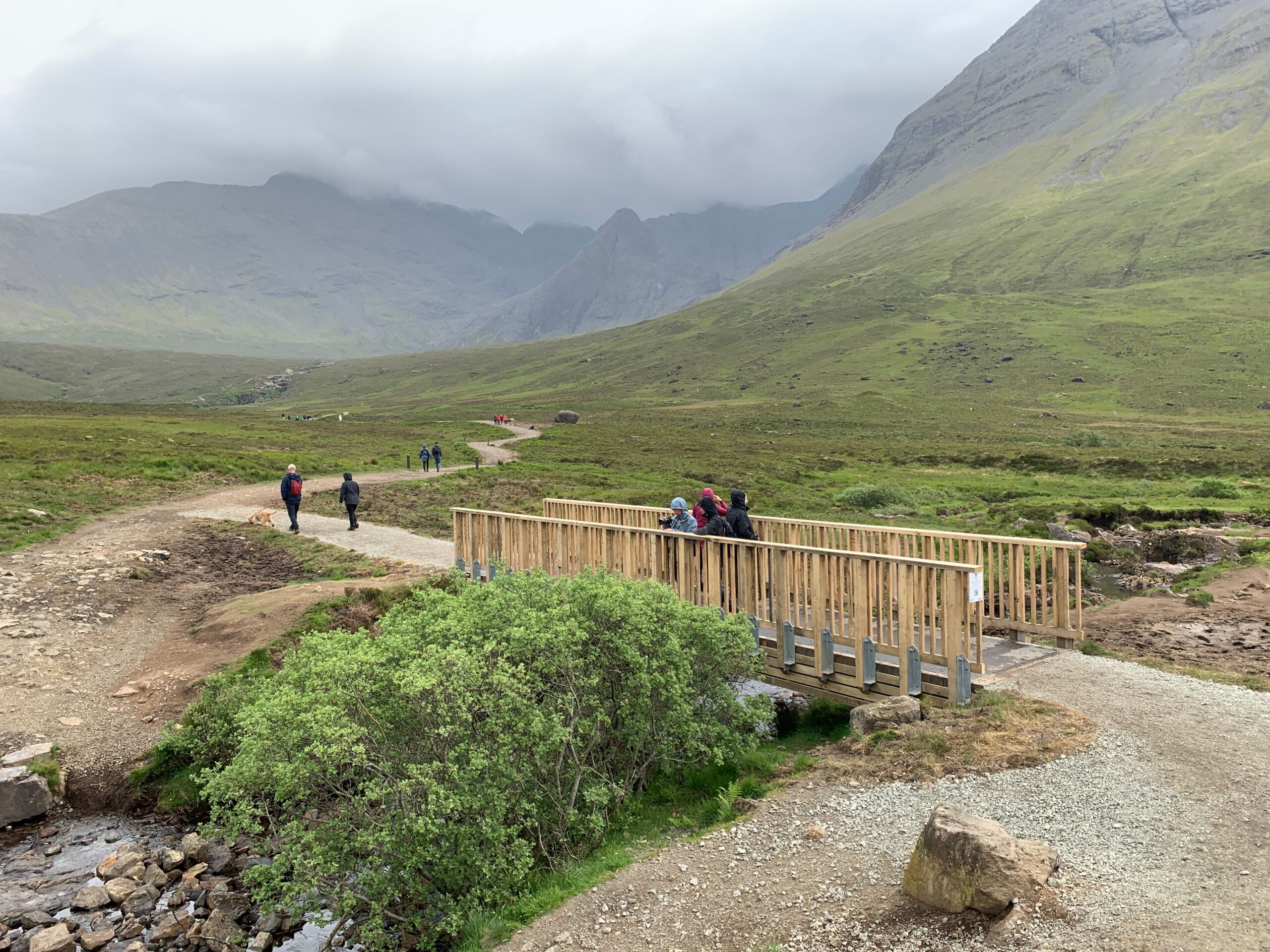
05 Jul New bridges, the way to safer accessibility at iconic Fairy Pools site
Visitors to one of Skye’s most iconic sites, the Fairy Pools, can now enjoy a safer walk across burns with the latest installation of two new bridges.
The newly installed bridges have been made with steel, and timber clad, to help improve accessibility and safety measures for those visiting the popular tourist destination, come rain or shine, and without the risk of falling in on the previously used open crossings. The popular tourist spot will also benefit from an extensive footpath upgrade which is due to be completed in March 2023.
The completed bridges form part of the ongoing work carried out by the Outdoor Access Trust for Scotland on the Skye Iconic Sites Project (SISP). The three-stage project will see the restoration and development of Skye’s most iconic sites including the Fairy Pools, Old Man of Storr and Quiraing.
Dougie Baird, CEO of Outdoor Access Trust Scotland said: “We’ve been hard at work installing two bridges that not only make the site more accessible but complement the dramatic landscape at the Fairy Pools.
“Before the installation of the timber bridges, access across the burns was difficult in wet and high water conditions, causing habitat damage along the bank sides where visitors looked for a place to cross. Now the bridges are complete, visitors can enjoy safe crossings whilst the habitat can have a chance to recover. We are looking forward to the next stage of upgrading the pathworks nearby, which will further enhance this beautiful site.”
Last month saw the official opening of the Quiraing footpaths with Cabinet Secretary for Finance and the Economy Kate Forbes present.
SISP is part of an almost £9 million Scottish programme of projects to invest in the Highlands and Islands to provide more and better-quality opportunities for visitors to enjoy natural and cultural heritage assets. The Natural and Cultural Heritage Fund is led by NatureScot and is part-funded through the European Regional Development Fund (ERDF).

Notes
The Skye Iconic Sites Project has a total budget of just under £1 million, having received £650,516 from the Natural and Cultural Heritage Fund (NCHF), led by NatureScot and part-funded through the European Regional Development Fund (ERDF). Additional partnership funding was secured from the Outdoor Access Trust for Scotland (OATS) (£98,793), Scottish Government Rural Payments Inspections Division (SGRPID) (£150,000), the Minginish Community Hall Association (£20,000), and Highland Council (£10,000).
The Natural and Cultural Heritage Fund (NCHF) is part of the Scottish Government’s current European Regional Development Fund (ERDF) programme, which runs through to 2023.
About Outdoor Access Trust for Scotland
The Outdoor Access Trust for Scotland (OATS) is a ground-breaking environmental charity promoting sustainable public access. It develops and implements path building and other outdoor access projects. For more information on OATS visit www.outdooracesstrustforscotland.org.uk.
More information on the Skye Iconic Sites Project (SISP) can be found here: www.outdooraccesstrustforscotland.org.uk/projects/skye-projects.
About NatureScot and the Natural and Cultural Heritage Fund
The Natural and Cultural Heritage Fund is funded through the European Regional Development Fund (ERDF) with an almost £9 million investment in the Highlands and Islands. The Natural and Cultural Heritage Fund will invest in the Highlands and Islands of Scotland to: provide more and better quality opportunities for visitors to enjoy natural and cultural heritage assets; encourage people to visit some of the more remote and rural areas; and create and sustain jobs, businesses and services in local communities. The purpose of the Fund is to promote and develop the outstanding natural and cultural heritage of the Highlands and Islands in a way that conserves and protects them.
The natural heritage includes natural habitats and wildlife, geology, and landscapes. Cultural heritage includes history, language, architecture, ancient monuments, historical sites and cultural landscapes and the sectors of theatre, arts, and literature. There is a close link between these two and interests often overlap. They are important locally and on a national and international scale.
They provide opportunities for the cultural and creative industries, environmental and tourism sectors.
The Scottish Government is the Managing Authority for the European Structural Funds 2014-20 Programme. For further information, visit their website or follow @scotgovESIF.
NatureScot is Scotland’s nature agency. We work to enhance our natural environment in Scotland and inspire everyone to care more about it. Our priority is a nature-rich future for Scotland and an effective response to the climate emergency. For more information, visit NatureScot website or follow us on Twitter at www.twitter.com/nature_scot.
